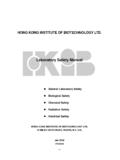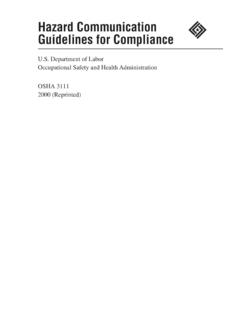Transcription of HSE information sheet
1 HSE information sheet industrial radiography - managing radiation risks Ionising radiation Protection Series No. 1(rev 1). Introduction This information sheet is for clients and main or principal contractors who engage specialist non . destructive testing (NDT) contractors to carry out a radiographic inspection. This includes inspection of products, operating plant, civil engineered structures or pipeline installations. The information sheet will also be relevant to managers of these NDT companies, self-employed contractors and companies who carry out in-house radiography . It does not give the full requirements of the Ionising Radiations Regulations 1999 (IRR99), as these can be obtained in the Approved Code of Practice and guidance supporting the Regulations, available from HSE Books 1.
2 The purpose of this information sheet is to focus on the management of health and safety risks arising from industrial radiography work by summarising precautions which, if followed, should help ensure compliance with IRR99's main health and safety requirements. Clients, main contractors and sub-contractors are all employers and have clear responsibilities under health and safety legislation. Contractors using sealed sources must also consider the requirements of the Radioactive Substances Act 1993, which are regulated by the Environment Agency. What is the problem? industrial radiography usually involves using intense radiation sources which can expose people at work to significant amounts of radiation . Over the years several serious incidents have been caused by the failure to maintain equipment, to carry out routine monitoring or to employ proper emergency procedures.
3 HSE inspectors have also found that a significant number of NDT contractors fail to adopt routine working practices capable of keeping radiation exposures of employees as low as reasonably practicable: this is the main requirement of IRR99. Incidents occur because of poor job planning (most notably with site radiography ), failure to use adequate local source shielding, or inadequate systems of work. Generally, people working in industrial radiography have received higher doses than those working in other sectors using ionising radiation . Too often, clients (or main contractors) can cause difficulties for their contractor by not allowing sufficient time or ensuring effective communication to plan work properly. There is rarely a valid reason for calling in an NDT contractor at the last minute.
4 This work is normally a vital part of a quality assurance process and should be carried out in a carefully planned way. Enclosure radiography v site radiography If the work involves routine radiography of readily moveable articles it is nearly always reasonably practicable to carry it out in an adequately shielded enclosure or cabinet. Where practicable, using a suitable shielded enclosure must always be the first choice for radiography work. The client can either construct an enclosure on site or arrange for articles to be transported to an enclosure at the contractor's yard. In some cases it may be practicable to build a temporary enclosure on site if the contract is of sufficient duration. Enclosures can make it far easier to restrict exposure and prevent accidental exposures (see regulation 8 IRR99).
5 This has a number of advantages over undertaking the work out of hours under 'open shop' conditions. It will make work safer and the client will also have much more flexibility about the timing of the work. When site radiography is considered the only practicable option, personal exposure restriction and risks should still be controlled, so far as practicable, by using local shielding and through appropriate administrative arrangements such as systems of work and radiation controlled area designation. Site radiography contractors need to give HSE seven days advance notification of each job, unless it is carried out in an adequately shielded enclosure or the work is a genuine emergency and HSE agrees a shorter period. In fact, material is often required to be moved off site, for example for stress relief or pressure testing, and a suitable stop off for radiography can often be organised during the shipment of the finished article.
6 Assessing the risks All employers have to carry out a risk assessment to satisfy regulation 3 of the Management of Health and Safety at Work Regulations 1999. Employers should review this risk assessment periodically to ensure that it remains valid. When product or plant requires radiographing, whether in-house or by contractors, the employers should assess as part of the general risk assessment how this can be done safely. This cannot be ignored in the case of subcontracted NDT work: the responsibility for providing a safe working environment rests on clients as well as contractors (see Planning for the job). In some cases, it may be appropriate to use NDT techniques that do not involve ionising radiation . It is advisable for clients to review their NDT requirements periodically with insurers and NDT contractors.
7 This will help identify cases where ultrasonic testing and other non-radiographic NDT techniques can be used, which would eliminate the risk from ionising radiation . Before they start any new work activities, radiography contractors have to make sure that their risk assessments are sufficient to cover the radiation protection aspects of that work (regulation 7 IRR99). They also have to consider the possibility of a radiation accident occurring and take reasonable steps to prevent this or to mitigate its consequences by drawing up emergency procedures and appointing a responsible person for administering them For site radiography work, the risk assessment made by the client (or main contractor) in control of the site should take into account any special features of the site.
8 This might be problems of access or lighting; manual handling or lifting equipment difficulties; or the need to isolate vessels or pipelines carrying dangerous materials or atmospheres. Planning for the job For engineering construction and maintenance work, the client and principal contractor will have explicit duties under the Construction (Design and Management) Regulations 1994 2 for the management of the entire project. Where the project includes radiographic inspection of plant, they should develop safe procedures, with the co-operation of the NDT contractor, at the planning stage. These details should be incorporated into the pre-tender health and safety plan by the planning supervisor and subsequently by the principal contractor for the construction phase health and safety plan.
9 On a nuclear licensed site, the licensee will generally oversee all work with ionising radiation , including radiography done by a specialist contractor (regulation 4(3) IRR99). The licensee will usually wish to check that people carrying out radiography on their site are suitably qualified (the British Institute of Non-Destructive Testing 3 holds details of suitable certification schemes) and experienced. They will also ensure that the people carrying out radiography follow the site's local rules and access arrangements, and receive information , instruction and training to enable them to carry out their work safely. All clients and main contractors have general duties under the Health and Safety at Work etc Act 1974. to make sure, so far as reasonably practicable, that the site is safe and without risks to health.
10 Clients also have responsibilities under the Management of Health and Safety at Work Regulations 1999 to co-operate with the contractor. They must provide information about risks on site and the precautions for dealing with these (including information on appointed people responsible for emergency procedures). This information will help the contractor to ensure that the work is properly planned and carried out. Remember, site radiography contractors need to give HSE at least seven days advance notification. This period of time is deemed necessary to enable consultations between client and contractor to take place, to review risk assessments and to allow any necessary variations to be incorporated into the local rules. These processes must be built into the planning of the job.
















